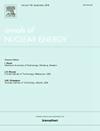Novel designs and performance appraisal of non-uniformly heated annuli for heat transfer augmentation with supercritical carbon dioxide
IF 1.9
3区 工程技术
Q1 NUCLEAR SCIENCE & TECHNOLOGY
引用次数: 0
Abstract
Deterioration of heat transfer and possible appearance of high temperatures are common concerns in supercritical flow channels, inspiring several innovating modifications in traditional tubes. Despite the relevance of annular geometry and rod bundles in high-power applications, similar efforts are quite rare in configurations beyond the conventional channels. Present study aims at addressing this research gap by proposing and analyzing two novel designs of supercritical flow channel with variable flow areas. Annular channels with continually increasing or decreasing heater diameter within a shell, accordingly allowing axial variation in heat flux based on the local thermal conditions, facilitate converging or diverging flow paths. Five different taper angles are contemplated for either of the geometries, and numerical simulations are performed to envisage their relative performances during energy addition with supercritical carbon dioxide as the working medium. Both the designs are able to demonstrate marked improvements in overall thermalhydraulic response, with the converging duct being identified as the more preferable choice. Local heat transfer coefficient at the channel exit can be as much as 126% greater for a converging channel compared to a plain annular one, without any significant rise in pressure losses. A converging channel is also able to maintain lower temperature levels throughout the flow path, and the effects are more prominent with greater tapering. Diverging channel also records considerable gain in heat transfer, but may experience higher local temperatures and augmented pressure losses. Buoyancy effect is found to be dominant within short entrance region, while flow acceleration governs the extent of interactions in later segments. Converging duct is able to sustain temperature close to pseudocritical value within the buffer region, which can be a primary reason for its superiority. The disparity between both configurations are less significant at lower flow rates and higher powers, and the use of diverging channel can be recommended only for large power-to-flow-rate ratios, which can limit temperature ranges better than converging channel only for such specific cases.
超临界二氧化碳增热非均匀加热环空的新设计与性能评价
传热恶化和可能出现的高温是超临界流道中常见的问题,激发了对传统管道的一些创新改造。尽管环空几何形状和抽油杆束在大功率应用中具有相关性,但在常规通道以外的配置中,类似的努力非常罕见。本研究旨在通过提出和分析两种新的变流面积超临界流道设计来弥补这一研究空白。在壳体内不断增大或减小加热器直径的环形通道,根据局部热条件,相应地允许热流密度的轴向变化,有利于流道的收敛或发散。考虑了这两种几何形状的五种不同的锥角,并进行了数值模拟,以设想它们在以超临界二氧化碳为工质的能量添加过程中的相对性能。这两种设计都能证明在整体热工响应方面有显著的改善,汇流管被认为是更可取的选择。与普通环形通道相比,收敛通道出口处的局部换热系数可高达126%,而压力损失没有明显增加。收敛通道还能够在整个流道中保持较低的温度水平,并且随着锥形的增大,效果更加突出。发散通道也记录了相当大的传热增益,但可能经历更高的局部温度和增加的压力损失。在短入口段内,浮力效应占主导地位,后段的相互作用程度由流动加速度决定。收敛风管能够在缓冲区域内维持接近假临界值的温度,这可能是其优势的主要原因。两种配置之间的差异在低流量和高功率时不太显著,并且只有在功率与流量比大的情况下才推荐使用发散通道,在这种特定情况下,发散通道比收敛通道更能限制温度范围。
本文章由计算机程序翻译,如有差异,请以英文原文为准。
求助全文
约1分钟内获得全文
求助全文
来源期刊

Annals of Nuclear Energy
工程技术-核科学技术
CiteScore
4.30
自引率
21.10%
发文量
632
审稿时长
7.3 months
期刊介绍:
Annals of Nuclear Energy provides an international medium for the communication of original research, ideas and developments in all areas of the field of nuclear energy science and technology. Its scope embraces nuclear fuel reserves, fuel cycles and cost, materials, processing, system and component technology (fission only), design and optimization, direct conversion of nuclear energy sources, environmental control, reactor physics, heat transfer and fluid dynamics, structural analysis, fuel management, future developments, nuclear fuel and safety, nuclear aerosol, neutron physics, computer technology (both software and hardware), risk assessment, radioactive waste disposal and reactor thermal hydraulics. Papers submitted to Annals need to demonstrate a clear link to nuclear power generation/nuclear engineering. Papers which deal with pure nuclear physics, pure health physics, imaging, or attenuation and shielding properties of concretes and various geological materials are not within the scope of the journal. Also, papers that deal with policy or economics are not within the scope of the journal.
 求助内容:
求助内容: 应助结果提醒方式:
应助结果提醒方式:


